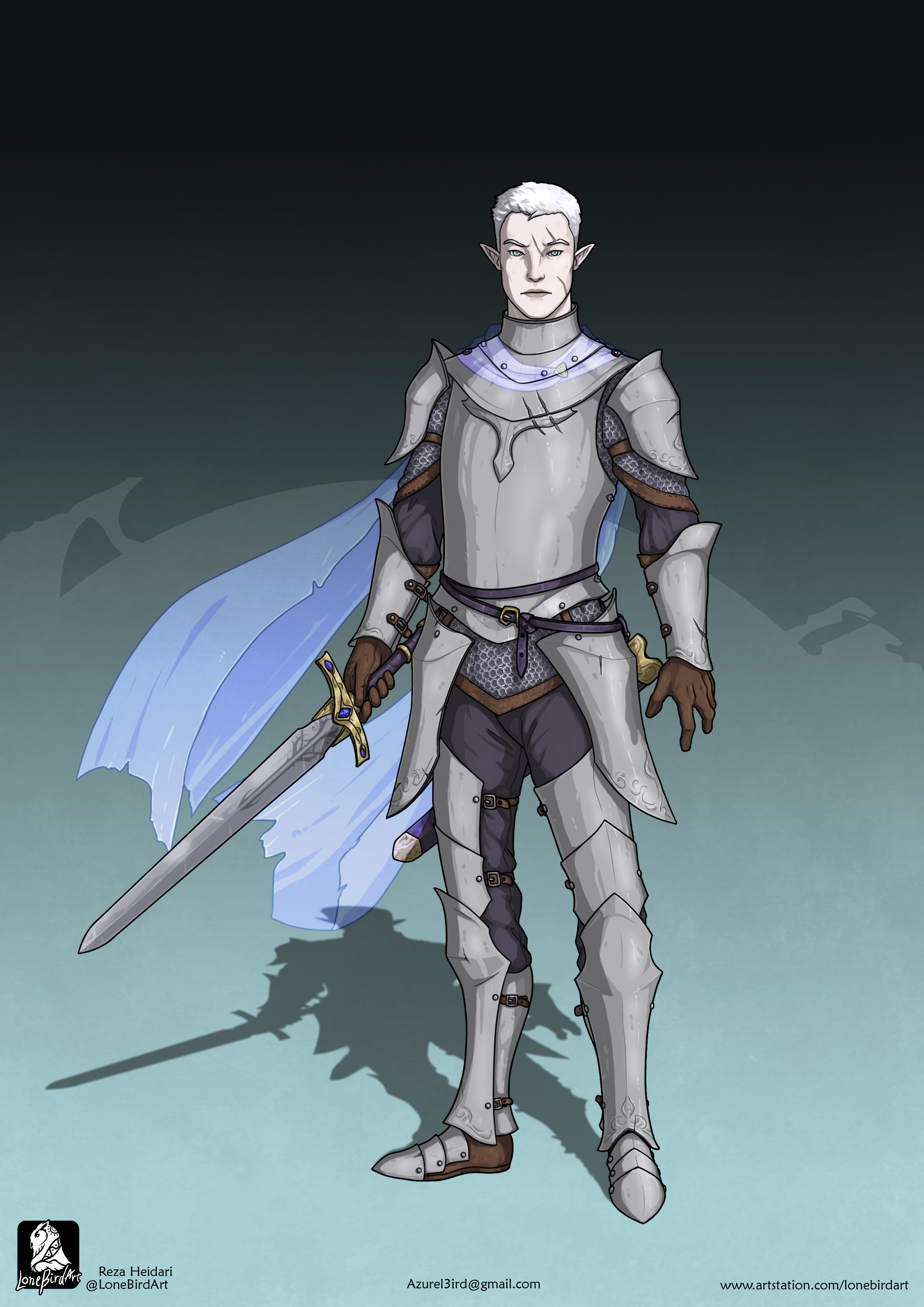The Frost Elves, also known as the Isvandari, have made their home in the frozen north, a place no other race could even dream of surviving in, no less thriving. The ruthless brutality of the icy wastes contrasts with their cities' elegant beauty, which proudly sit like gleaming jewels of the northern lands. Isvander Elven warriors are renowned for their grace and elegance in battle, while their nimble and speedy builds have created some of
Nostrina's greatest rouges.
Appearance
Built to survive in the frozen north, the skin of Frost Elves is exceptionally protective against the cold. A Frost Elf can survive in temperatures well below freezing without any clothing, making them perfectly adapted to the freezing weather. Their hair, which has a naturally silky texture, is often white or silver-white, though some elves can be born with red or black hair. Much like the
Roctane of Stelwen, Frost Elves developed sharper facial features than the
Cardinal Elves' rounder, more human-like faces. Besides their skin, what makes Frost Elves stand out the most from their elven kin is their slim frames, which give them greater speed and agility. Some elves have even developed techniques that allow them to run across ice without slipping or cracking it. Most mysteriously, the natural lifespan of Frost Elves far exceeds any other race on Nostrina by multiple centuries, with some able to live for over half a millennium.
History
Origins
As the Decentur faith took its hold on the elves of the Genesis Peninsula during the mid 800's AE, some found themselves growing distant towards their kin. Instead of becoming prideful of who they were and forging a new future for the elven people, they choose to wallow in self-pity and shame. The majority of the elves were enamored with the words of the Prophet Magnus, although two groups found themselves alienated by the spread of the Decentur faith and chose to leave the Genesis Peninsula. One group would head south and eventually sail to what would soon be known as Stelwen, while the second headed north. Knowing they would find no respite within the Arrini empire, the migrating elves continued heading north. These nomadic elves were known as the Wandering Elves, aimlessly traveling from place to place, searching for a place to call their own. The Wandering Elves persisted despite many hardships and setbacks, eventually establishing a home in the Vintervei region circa 890 AE.
As the new elven settlements in Vintervei grew, ambitious elves chose to continue wandering north into the snow-covered lands. Many of these bands established their small colonies across the vast landscape of Kronenstien. However, many of these colonies have fallen to ruin due to abandonment or conflict with native humans. The only genuinely successful settlement was founded by Isophus Celer, who seemingly couldn't give up on the nomadic life and traveled far to the northwest of Kronenstein to the Northern Crest. The elves of Isophus's colony were resourceful and conquered any challenge they faced from the land. Soon Isophus and his followers were approached by local humans, but rather than seeking conflict, these humans sought peace.
Despite doubts from both humans and elves, the alliance between Isophus's colony and the native peoples held firm. Word of the newfound peace in the far north made its way across Kronenstien, with some of the smaller colonies choosing to migrate to the Northern Crest. The first elven settlement in the Vintervei, a failing settlement due to poor leadership and still dealing with the aftermath of a minor armed conflict with raiders, faced a mass exodus as many elves decided to flee the failing town; the fate of those who chose to stay remains unknown.
As this era went on, the elves' mysterious evolution began to take effect. To better acclimate to the colder weather, their skin shifted into the white-blue color of modern Frost Elves while becoming increasingly more resistant to the cold. As time went on, their nimble frames and sharper facial features began to develop among the population of elves living in Kronenstien. As with other elven species, why their bodies underwent the changes they did is a question that remains unanswered.
Enceladan Crossing
By the year 942 AE, nearly the entire population of Frost Elves lived in the Northern Crest of modern-day Kronenstien. The Alvjen Pact led by Nicodemus Abito and Jarl Torfinn had formed into the jointly ruled nation of Alvjenhiem. There was an unprecedented peace among the two races, which had fought since the day elves arrived in the region. Despite the peace, some elves were dissatisfied with the alliance. Over the years, the many elves adopted the humans' ways and seemingly abandoned their elven heritage in the eyes of some elves. Telestis Lupin was among this group, who felt that assimilating with the humans spat in the face of their forefathers who left the Genesis Peninsula to forge their own identity.
In 997 AE, Telestis and other elves attempted to break away from Alvjenhiem by revolting, this attempt was quickly thwarted, resulting in Telestis and his followers being exiled. The separatists braved the icy waters of the Hoarfrost Sea, sailing west until they reached the frozen wasteland of Enceladus. Thanks to their adaptations, the elves were able to survive in the brutal conditions long enough to form a stable colony on the continent's eastern shore. With no other groups to compete with, the elves grew into a nation spanning the entire continent of Enceladus. For the longest time, Enceladus remained isolated from the rest of the world until they made contact with the eastern neighbors centuries later.
(Redacted)
General order to all Sillris agents
All information regarding (redacted) is catastrophically dangerous to the security of Enceladus and must be safeguarded from the general public by any means necessary. Blockades and barriers have already been erected to keep intruders from entering (redacted). Anyone who approaches (redacted) without the proper clearances will be killed immediately. Agents must destroy all documents with any mention of (redacted) and kill the document's author. Citizens with any knowledge of (redacted) must be killed and disposed of with the utmost discretion to prevent suspicion among the population. Agents who are discovered or release information to the public will be killed immediately, along with any who may have had contact with the defecting agent.
Failure is not an option.
Society
Culture
Culturally, the Frost Elves are divided between the Eastern and Enceladan elves. The elves of Kronenstien have adopted many of the customs and traditions of their Forvir neighbors. Contrasting them, the culture of those living in the inhospitable land of Enceladus is one of the most unique in all of Nostrina.
Ambition is perhaps one of the most important things to a Frost Elf hailing from Enceladus. It was the ambition to carve a new future away from the dogma of the Prophet Magnus that made the Frost Elves who they were. Though similar ambition, the Enceladan elves left Kronenstien and settled in Enceladus, escaping the human-elf alliance that would've stripped them of their identity. The elves of Enceladus are constantly pushed to follow through with their personal ambitions, whether it be one involving personal gain or political maneuvers. Another avenue in life for an elf in Enceladus is one of faith and mentorship, as those devout to the teachings of Regnatel are encouraged to join the Sennuial Enclave and become spiritual teachers to their fellow elves.
The elves of Kronenstien share a strong bond with their human allies, practicing the same customs and worshiping the same gods. All the way down to their language and names, the Eastern Frost Elves have assimilated with the Forvir people while still practicing their way of life. Regnatel and her sister goddess Afiren are the driving forces behind much of the customs of the Eastern Frost Elves. Afiren, the goddess of intelligence and cunning, is the patron to those who practice the arcane arts, often known as Flinkmen or Flinkalver in Kronenstien. Many elves are taught at least some form of magic they use in their daily lives.
Language
As with many aspects involving the Frost Elves, their language is split between the Enceladan and Eastern elves. The Frost Elves of the frigid north speak their namesake language, Enceladan, a tongue that combines aspects from both the ancient Arrinri dialect and the tongue of the Forvir, Fortival.
Naming Conventions
Eastern Frost Elves have adopted the naming conventions of their human allies in Kronenstien. Arrini naming conventions were abandoned alongside the language in favor of adopting the traditions of their human neighbors to strengthen the alliance between them. Interestingly, some family names dating back to their Cardinal Elven roots still lingers thousands of years later among the Eastern Frost Elves.
The names of the Enceladan Frost Elves are quite distinct, bucking both Arrini and Forvir conventions entirely. Frost Elves from Enceladus have one primary name, with familial names known and spoken only between blood relatives. Learning and speaking an Enceladan's familial name when you're not related to them is considered incredibly disrespectful and rude.
Art and Architecture
Walking the streets of an Enceladan city is an experience one can't find anywhere else in Nostrina. The brilliant stone buildings stand proud against the bitter winds, with the streets giving off an enchanted feeling as one strolls through the city. Lighting the roads are light posts using magical energies that never give out. Perhaps one of the most distinct parts of Frost Elven architecture is the buildings made of Sternagal, magical ice as hard as stone.
The architectural styles of the Eastern Frost Elves is mostly the same as their Forvir neighbors, though some older structures were built in a manner similar to those found in the Arrini empire.
Religion
The religion of both primary Frost Elven cultures centers around a goddess known as Regnatel, the Shepparding Light. She is often depicted as the North Star, which the elves used for navigation in their early days as nomads. Regnatel teaches pride and appreciation of their elven traits and opposes the Decentur Faith teachings of sin and shame.
For most Frost Elves, living their lives to its greatest extent is their way of praising the sheppard of their people. Those more involved with the faith venerate Regnatel through sacrifices and rituals meant to keep the Shepparding light ablaze. The primary religious organization within Enceladus is Sennuial Enclave, stationed out of the capital city of Gellathyll. The Enclave holds responsibility in maintaining all temples and shrines and being spiritual mentors to the Frost Elves. Each temple represents different lessons Regnatel taught the elves, which new members of the Enclave with learn during a pilgrimage visiting each temple.
The Eastern Frost Elves worship both Regnatel along with the gods venerated by the Forvir. They consider her as both the Shepparding Light as their Enceladan counterparts do, but also the goddess of alliances. Within the Forvir pantheon, she is the sister of Afiren, the goddess of intelligence and ingenuity. Her worship has wormed its way into the faith of their human allies, although small pockets of the Forvir believe her to be solely an elven goddess.




This is really in depth, I enjoyed reading through the information. I like the trait of a longer lifespan, that is a unique spin. I will have to read more into your other workings, fellow jester. :)